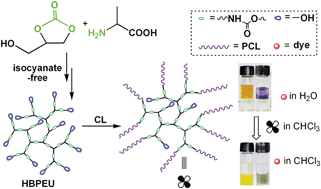Water-soluble hyperbranched poly(ester urethane)s based on d,l-alanine: isocyanate-free synthesis, post-functionalization and application†
Abstract
The green synthesis of a novel hyperbranched poly(ester urethane) (HBPEU) has been reported via an

* Corresponding authors
a
State Key Laboratory of Polymer Physics and Chemistry, Changchun Institute of Applied Chemistry, Chinese Academy of Sciences, Changchun 130022, China
E-mail:
ysli@ciac.jl.cn
b Graduate School of the Chinese Academy of Sciences, Changchun Branch, Changchun 130022, China
c College of Environment & Chemical Engineering, Yanshan University, Qinhuangdao, China
The green synthesis of a novel hyperbranched poly(ester urethane) (HBPEU) has been reported via an

 Please wait while we load your content...
Something went wrong. Try again?
Please wait while we load your content...
Something went wrong. Try again?
Y. Bao, G. Shen, J. He and Y. Li, Green Chem., 2012, 14, 2243 DOI: 10.1039/C2GC35261C
To request permission to reproduce material from this article, please go to the Copyright Clearance Center request page.
If you are an author contributing to an RSC publication, you do not need to request permission provided correct acknowledgement is given.
If you are the author of this article, you do not need to request permission to reproduce figures and diagrams provided correct acknowledgement is given. If you want to reproduce the whole article in a third-party publication (excluding your thesis/dissertation for which permission is not required) please go to the Copyright Clearance Center request page.
Read more about how to correctly acknowledge RSC content.
 Fetching data from CrossRef.
Fetching data from CrossRef.
This may take some time to load.
Loading related content
